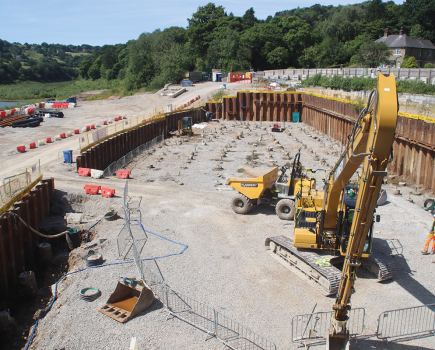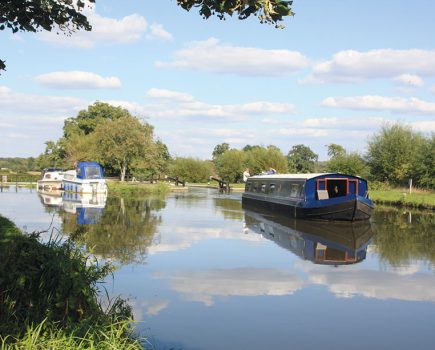They’d reached Lincoln the year before, so decided to be even braver and set their sights on Boston – with plenty to see and enjoy en route

Words and pictures: Martin & Margaret Eades
We decided we would like to have an adventure holiday and spend a week going to Boston. No, not Massachusetts, but the one in Lincolnshire where the original Pilgrim Fathers sailed from to escape religious persecution in the 17th century.
Our boat is an ageing Viking 26, centre cockpit cruiser called Grace Darling. As our earlier boats were seagoing types, Martin was convinced the latest, aptly named and moored so far away from the coast, should have her hull wet by sea water.

Starting from our home base at Shardlow Marina in August, we sailed on the River Trent. We went through the twin locks at Sawley to Trent Lock Junction and continued to Beeston Canal, which operates through the centre of Nottingham.
Travelling through busy city centres is fascinating – many worlds exist side by side. Our leisurely four miles an hour gave us time to gaze at traffic rushing along motorways and people sitting at canalside cafés staring back at us. Warehouses, old factories, bridges, moored boats and back gardens add to the variety of things to see as you gently make your way, towards the suburbs.
The canal locks back into the river at Trent Bridge and an excellent view of Nottingham Forest football ground can be seen. Back on the river, we made our way along past Holme Pierrepont to the quiet and secluded Stoke Lock, where we moored for the night. The locks after Nottingham are built for seagoing ships, and we would call up each lock-keeper on the short wave radio to inform them we were coming so they would tell us when the lock would be opened for us.

The next day, we took four and a half hours to get to Newark, the place to shop for provisions and fuel. It also offered the chance to have a look round the ancient castle where King John died, after having lost the Crown Jewels in The Wash!
From there, we continued to the largest lock on the Trent, Cromwell Lock. After this point, the river becomes tidal, meaning navigation charts are necessary to guide a vessel through sandbanks and low-tide hazards. More seagoing and larger craft were now predominant and there is evidence of past gravel digging industry on the river banks.
We aimed for Torksey, a village at the junction of the Trent and Fossdyke & Witham Navigation. Having tied up on a pontoon until the rising tidal water was deep enough to allow us to pass over the cill into Torksey Lock and on to the Fossdyke Canal, we stopped for the night before proceeding down this Roman waterway towards Lincoln the next day.

At Lincoln, our son Julian joined us for a few days for the rest of the journey to Boston.
After a night’s stay at the delightful town marina at Brayford Pool, we proceeded through the Murder Hole (a low bridge with a medieval house above) and on to the foreboding Stamp End Lock, which was our first experience of an electric guillotine lock.
Having completed the Fossdyke Canal, this next section is the River Witham, which eventually leads to the sea at The Wash.

An unexpected hazard presented itself at Bardney, where we came across dense weed. It hampered our way and caused a real problem for the engine, threatening to block the cooling water intake.
We met a few other boat owners who told us this was a seasonal problem for boats, and can be so bad sometimes that you have to turn back. We saw a narrow clearing in the weeds and decided to proceed with caution. Fortunately, the weed eventually started to become clearer as we continued.
The scenery became more rural, flat and fen-like as we passed Tattershall Bridge where we had another peaceful overnight stay. The next day, we had Boston in our sights and, after a relaxing cruise, the famous ‘stump’ of St Botolph’s Church, navigational aid and distinctive lantern tower of the famous parish church, could be seen.

The marina at Boston was centrally placed with its pontoons giving us easy access to the town and all its amenities. Sunday morning was spent attending the church with its stump for sung Eucharist. It is reputed to be the largest parish church in England, and we were overwhelmed by its size and openness. It is larger than some cathedrals.
While exploring the town, we saw the Grand Sluice, a lock letting the river navigation through to the river estuary and into The Wash, on to the sea. The lock is only opened at two hours before high water and two hours afterwards when the estuary and river levels are the same.
Julian had to leave us for the train back to Thame so we spent the rest of the day relaxing before starting the return journey.

We retraced our steps and, on arriving at Bardney, we noticed a weed removal van parked on the riverside, and the river much clearer of its weed. Another day’s journey took us back to Lincoln, where we met our second passenger/crew, our niece Ann. We enjoyed a day exploring the newly refurbished castle.
As it was the 800th anniversary of the signing of Magna Carta in 2015, we made the most of the opportunity, seeing the exhibition of Lincoln’s own copy as well as other important historic documents housed in the old prison within the castle grounds.
We explored the historic area by the riverside, the Glory Hole or Murder Hole – so called because of the gruesome incidents which happened at this spot in the Middle Ages.

The next day we continued on our journey via Torksey Lock, the River Trent and Cromwell Lock, eventually to the familiar Trent Lock at Long Eaton and home to Shardlow.
In all, we travelled for 50 hours, covering 225 lock miles.
Thank you Martin and Margaret for sending in your story.
Now it’s your turn to tell us about the boats in your life. If you would like to be featured in Me & My Boats in a future issue of Canal Boat magazine, send your story (about 1,000 words) and photographs (don’t worry, we’ll return them!) to editor@canalboat.co.uk. If it’s used, you’ll win £100!
_____________________
You may also like:
An impulse buy and a boating dream come true
Me & My Boats: Carolyn Easdale
Me & My Boats: swapping the Canal du Midi for the Kennet and Avon
Image(s) provided by:
Archant







